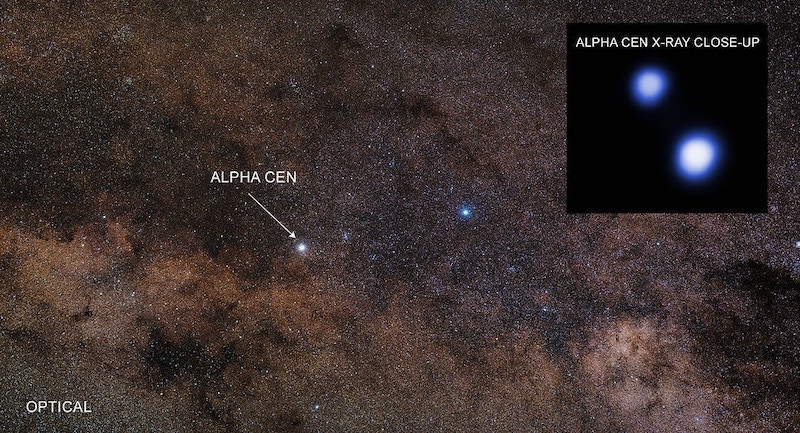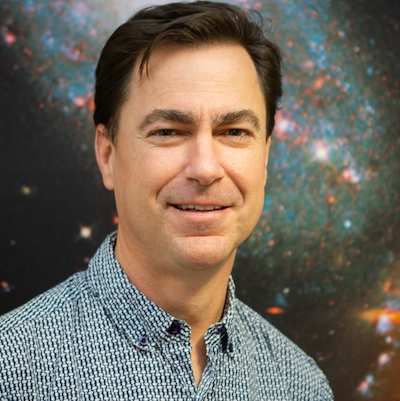
Could there be habitable planets – or even life itself – in the star system nearest to our sun? That’s the question scientists want to answer, and on November 17, 2021, they announced a new space telescope mission called TOLIMAN to find out if there are any nearby habitable planets in the closest star system, Alpha Centauri. TOLIMAN, which stands for Telescope for Orbit Locus Interferometric Monitoring of our Astronomical Neighborhood, is also an old Arabic name for Alpha Centauri. Scientists custom designed TOLIMAN to search for worlds around our stellar next-door neighbors.
EarthSky 2022 lunar calendars now available! They make great gifts. Order now. Going fast!
The nearest star system to our own
Alpha Centauri is the closest star system to our sun, at just over 4 light-years away. However, unlike our sun, it consists of not one but three stars. Two of them are similar to the sun and the other is a red dwarf. The two sun-like stars, Alpha Centauri A and Alpha Centauri B, are just 4.37 light-years away from us. The red dwarf that orbits them, Proxima Centauri, is only 4.25 light-years away.
So far, there are no confirmed planets around the main two stars (though one is suspected). But there is one known planet orbiting Proxima Centauri. This planet, Proxima Centauri b, has the classification of a super-Earth though it’s just a tad bigger than Earth. (Its mass is 1.27 Earths and estimated diameter is 1.08 Earths.) Discovered in 2016, it orbits within the habitable zone of the star, the region where temperatures are suitable for liquid water to exist. It takes 11.2 days to complete an orbit around the star.
Little else is known about this world so far, but it certainly warrants further study. Being about the same size as Earth, and in the habitable zone, doesn’t on its own prove it is habitable, but it could be. And, if there is one planet, might there be others, as-yet undiscovered?

Nearby habitable planets around Alpha Centauri?
TOLIMAN will search for other planets around Proxima Centauri and additional planets in the Alpha Centauri system. Ones in the habitable zone of any of the stars would, of course, be of key interest. Pete Worden, executive director of Breakthrough Initiatives, said in a statement:
Our nearest stellar neighbors – the Alpha Centauri and Proxima Centauri systems – are turning out to be extraordinarily interesting. The TOLIMAN mission will be a huge step towards finding out if planets capable of supporting life exist there.
Notably, even after the discovery of thousands of exoplanets, we still know little about planets around the nearest stars in the solar neighborhood. Peter Tuthill, project leader for TOLIMAN, said:
Astronomers have access to amazing technologies that allow us to find thousands of planets circling stars across vast reaches of the galaxy. Yet we hardly know anything about our own celestial backyard. It is a modern problem to have; we are like net-savvy urbanites whose social media connections are global, but we don’t know anyone living on our own block.
Tuthill continued:
Getting to know our planetary neighbors is hugely important. These next-door planets are the ones where we have the best prospects for finding and analyzing atmospheres, surface chemistry and possibly even the fingerprints of a biosphere: the tentative signals of life.

The TOLIMAN project
Work on the project began last April. TOLIMAN is a collaboration of Breakthrough Initiatives, Saber Astronautics and NASA’s Jet Propulsion Laboratory (JPL).
Pete Klupar, chief engineer of Breakthrough Watch (part of Breakthrough Initiative), said:
These nearby planets are where humanity will take our first steps into interstellar space using high-speed, futuristic robotic probes. If we consider the nearest few dozen stars, we expect a handful of rocky planets like Earth orbiting at the right distance for liquid surface water to be possible.
Some of the financing for the project comes from Saber Astronautics, which received $788,000 in the International Space Investment: Expand Capability grant from the Australian government. In addition, Saber will also provide spaceflight mission operations support, such as satellite communications and command, space traffic management and other flight services. As noted by Tuthill:
Saber is a critical part of the mission.

According to Saber CEO Jason Held:
TOLIMAN is a mission that Australia should be very proud of. It is an exciting, bleeding-edge space telescope supplied by an exceptional international collaboration. It will be a joy to fly this bird.
A space telescope for nearby habitable planets
Unlike TOLIMAN’s focus on our near neighborhood, other telescopes, such as Kepler and TESS, have focused on more distant stars. Searching for them around closer, brighter stars, however, requires additional fine-tuning of the instruments. As Eduardo Bendek at JPL said:
Our TOLIMAN mission will launch a custom-designed space telescope that makes extremely fine measurements of the position of the star in the sky. If there is a planet orbiting the star, it will tug on the star betraying a tiny, but measurable, wobble.

More specifically, the diffractive pupil mirror pattern spreads starlight into a complex flower pattern. This makes it easier to show the fine detail needed to detect the small wobbles a planet would make in the star’s motion.
TOLIMAN fills an important niche in the study of exoplanets, searching for them around the very nearest stars. As has been noted, that task has actually been more difficult, so far, than finding planets around more distant stars. TOLIMAN will focus on detecting these worlds, if they are there. What will it find?
Bottom line: A new custom-designed space telescope mission called TOLIMAN will search for nearby habitable planets in the closest star system to Earth, Alpha Centauri.











